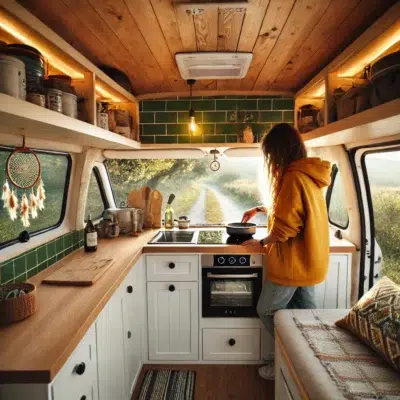Master the Art of Off-Grid Induction Cooking: Your Ultimate Guide
For many Australian travellers, having a reliable cooking setup is just as important as a good 12V system. Whether you’re touring in a caravan, heading off-grid in a 4WD, or setting up camp in remote locations, you need a practical and efficient way to prepare meals.
For years, gas stoves have been the go-to choice. However, with advances in lithium battery systems, inverters, and solar technology, many travellers are making the switch to induction cooktops. But is it the right choice for you?
This guide will break down the pros, cons, power requirements, and real-world experiences so you can make an informed decision.
Why Induction Cooking is Gaining Popularity for Camping & Touring
Induction cooktops use electromagnetic energy to heat cookware directly, making them highly efficient. Unlike gas or traditional electric stoves, induction heats only the pot or pan, reducing wasted energy.
Benefits of Induction Cooking for 4WD and Caravan Travel
- Heats up quickly, reducing cooking time
- High energy efficiency, with up to 90% of energy going directly into the cookware
- No open flame, reducing fire hazards and gas leak risks
- Eliminates the need for gas bottles, saving space and weight
- Easy to clean with a flat glass surface
- No gas fumes or added moisture inside your caravan
While these benefits make induction a great option, it’s important to consider the power requirements and potential challenges before making the switch.
Challenges of Using Induction Cooktops While Camping
- High power consumption, requiring a well-designed battery and inverter system
- Requires compatible cookware (stainless steel or cast iron)
- Higher upfront cost to upgrade your 12V system
- Some models may require a modified cooking style due to automatic power adjustments
To run an induction cooktop effectively, you will need a sufficient battery, inverter, and solar charging system to handle the power draw.
Induction vs Gas: Which One is Better for Your Setup?
| Feature | Induction Cooktop | Gas Stove |
|---|---|---|
| Cooking Speed | Faster | Slower |
| Efficiency | High (90% energy to cookware) | Lower (heat lost into the air) |
| Safety | No flame, no gas leaks, auto shut-off | Open flame, gas leaks possible |
| Setup Requirements | Requires lithium battery, inverter, and solar | Requires gas bottles and plumbing |
| Weight & Storage | Lighter (no gas bottles needed) | Heavier due to gas bottles |
| Cost | Higher upfront (battery + inverter) | Lower upfront, but requires gas refills |
| Suitability for Indoor Cooking | Ideal – no fumes or added moisture | Needs good ventilation |
Gas remains a popular choice for budget-conscious travellers and those without the electrical capacity for induction. However, for those investing in a 12V lithium power system, induction offers a more convenient, efficient, and safer cooking solution.
How Much Power Do You Need to Run an Induction Cooktop?
Most induction cooktops draw between 1,000W and 2,400W per burner, meaning a sufficient 12V power system is essential.
Estimated Power Consumption from a 12V Battery
- Boiling water for 5 minutes on high – 14Ah used
- Cooking a meal for 20 minutes on medium heat – 28Ah used
- Simmering for 30 minutes on low heat – 20Ah used
Recommended 12V Setup for Induction Cooking
- Lithium Battery System (200Ah minimum, 400Ah recommended) – Induction cooktops drain power quickly, so lithium is essential
- Pure Sine Wave Inverter (2,000W minimum, 3,000W recommended) – A standard 1,000W inverter will not be sufficient
- Solar Panels (400W – 600W) – Helps replenish your battery throughout the day
- DC-DC Charger (40A or higher) – Keeps your battery charged while driving
At Sandgate Auto Electrics & Automotive Services in Brisbane, we custom design and install 12V systems to ensure you have enough power to run an induction cooktop while travelling.
Real-World Experience: See It in Action
If you’re still unsure about whether induction cooking is the right choice for your setup, check out Explore Bound’s video, where Dan (a seasoned traveller!) shares his first-hand experience with induction cooking on the road:
This provides a realistic look at power usage, convenience, and overall practicality for long-term travel.
Get a Custom 12V Setup for Your Induction Cooktop in Brisbane
If you’re considering switching to induction cooking, your 12V power system needs to be designed correctly. At Sandgate Auto Electrics & Automotive Services, we specialise in:
- Lithium battery installations
- Pure sine wave inverter setups
- Off-grid solar systems
- Custom caravan and 4WD power solutions
Why Choose Us?
- Tailored 12V solutions designed for your specific power needs
- Expert installations for safe and reliable performance
- High-quality lithium batteries, inverters, and solar gear
- Brisbane-based auto electrical specialists conveniently located in Sandgate
Final Thoughts
Induction cooking is efficient, modern, and hassle-free, but it requires a properly designed electrical system. With the right battery, inverter, and solar setup, you can enjoy fast, safe, and reliable cooking whether you are off-grid or at a powered campsite.
If you’re thinking about making the switch, Sandgate Auto Electrics & Automotive Services in Brisbane can help you install a 12V power system that works for your travel needs.
Visit us at Sandgate Auto Electrics & Automotive Services or contact us today for expert advice and installations.


